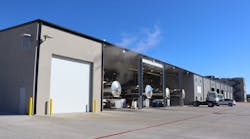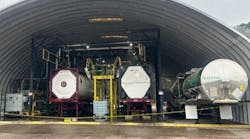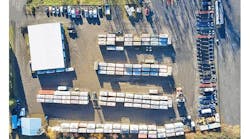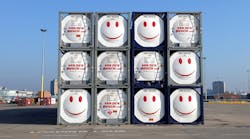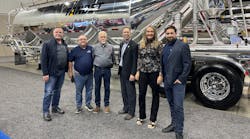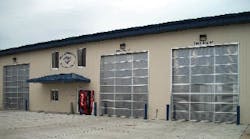ONE OF the newest commercial foodgrade wash racks in the Midwest opened in mid-2009 in Le Mars, Iowa. Blue Diamond Tank & Truck Wash can handle a wide range of foodgrade products.
The wash rack is open from 7 am to 5 pm Monday through Friday and 7 am to noon on Saturday. The wash rack staff also responds to call outs at other times. The facility is at 990 6th Street SW, Le Mars, Iowa 51031. The phone number is 712-546-4446, and the fax number is 712-546-4623. Jim Cameron is an owner and general manager.
“We've operated a small wash rack in Le Mars for foodgrade dry bulk trailers for a number of years,” Cameron says. “We had begun to see a growing number of liquid bulk food shipments through this area up in the northwest corner of Iowa. Cargoes include milk, tallow and lard, and juices. We can clean all of those and more. We can handle any foodgrade product. We do not take hazardous materials and we encourage customers to call for limitations.
“Our original one-bay dry bulk trailer wash rack will remain open. Both locations now operate under the Blue Diamond name, and they are both busy.”
Kosher wash rack
Blue Diamond has received cleaning approvals from dairy processor organizations, kosher authorities, and ConAgra Foods Inc. Cargill Inc approval is pending.
The new foodgrade wash rack has two internal tank cleaning bays and one exterior wash bay. Two more cleaning bays could be added to the building to handle future growth. Cleaning services include steam heating, kosherization of tank trailers, and tank passivation. Enough parking is available to handle up to 60 tank trailers.
“Most of the passivation requests we get are for new tank trailers that are being put into service,” Cameron says. “Some customers also want to repassivate tanks that have been in service for a number of years. We use a foodgrade-quality acid for passivation.”
Driver features include a lounge with high-definition television and wireless internet access, a fully equipped kitchen, and showers. “We'll stock the refrigerator with food as the cleaning volume grows,” Cameron says.
Construction project
Work on the new wash rack started in December 2008, and the facility was operational by July 2009. Winter weather caused a few minor construction delays, but the project moved forward to completion without any major hiccups.
The two tank wash bays are together in an area that is 50 feet by 100 feet. The exterior wash bay is 35-feet by 100-feet. Ceilings in the wash bays are 20-feet high. The cement floor has a 16-inch slope and is heated by glycol circulated through tubing.
Wash bay walls were constructed of molded vinyl panels with vertical cells that were filled with concrete as the walls were assembled. The complete walls are 10-inches thick. The light tan vinyl panels do a good job of reflecting light into the work area.
The wash bays are illuminated by T9 fluorescent fixtures, chosen because they provide greater light and are more energy efficient. “We wanted to ensure a bright, safe work area for our tank cleaners,” Cameron says.
Adding to the overall brightness in the wash bays are rollup doors with translucent panels that let in plenty of daylight. The polycarbonate panels resist impact damage and are mounted in an aluminum frame.
The galvanized steel mezzanine and work platform in tank wash bays was designed in-house and fabricated from scratch by a local welder. The structure includes a fall protection cage that drops into place when wash workers lower access ramps to the tank trailers.
Wash system
The tank cleaning bays are served by a stainless steel SaniMatic wash system with two 110-gallon CIP tanks — one for each spinner and three 430-gallon rinse recovery tanks. The system has enough capacity to clean two trailers at a time. Both bays have stainless steel Lechler spinners.
The system recirculates hot water, which is maintained at 190° F. Foodgrade detergent is added directly into the wash water stream, which is discarded after the tank trailer is cleaned. Steam for the cleaning operation comes from a 250-horsepower boiler.
Wastewater from the cleaning process is routed through a separator that removes solids and oils. The wastewater is then released into the sewer. ♦
